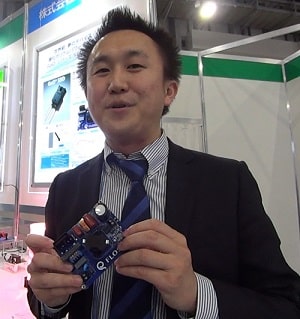Most power devices are generally made of silicon carbide. However, a small company from Japan intends to change that by offering gallium oxide power devices. In an interaction with Takuto Igawa, Co-founder and Vice President of Sales, Flosfia, Rahul Chopra of EFY found out more at the Automotive World Expo 2020 held in Japan earlier this year.

Q. What is special about your product?
A. In terms of power devices, these days the silicon carbide or gallium nitride are getting popular in the world but we are focusing on gallium oxide, which is a completely new material and affordable from a cost perspective.
Q. Who would be the ideal customers for your gallium oxide power devices?
A. Our first product, which is gallium oxide Schottky diode is great for electronics design engineers who are involved in developing AC-DC switching supplies. Specs-wise, the breakdown voltage is 600V and current is 10 A.
Q. Any application of AC-DC switching supply within that range?
A. If you look at 600V and 10A, the biggest application should be data centre or OBC (On-Board Charger) for EV (Electric Vehicle) or DC-DC for EV as well.
Q. For the design engineers, who are not sure whether gallium oxide is a good option or not, especially for Schottky diodes, what would your suggestion be?
A. Our package, 30220, is a combination of several packages. So, by doing ample research on pin-to-pin comparisons, they can check the quality of our device.
Q. How will the engineers and their product benefit by using gallium oxide SPD (Surge Protection Device) vs SiC (Silicon Carbide) or gallium nitride?
A. By doing pin to pin comparison of gallium oxide, they should be able to notice that its efficiency is better than silicon carbide. On top of that, the noise effect should be improved by using this material. So, they can benefit from the efficiency and reduced noise like EMIC.
Q. How will a higher efficiency help them to sell their product to a customer?
A. From a sales perspective, the device has a reduced cost as compared to silicon carbide. Besides that, the quality of our device, in terms of efficiency and noise is much better than silicon carbide.
Q. Do you have any evaluation board for this?
A. Yes, we are developing an evaluation board.
Q. If a customer in India wants the evaluation board, how can they reach out to you?
A. They can contact us through our homepage.
Q. Are there any global reports available which indicate the device’s power and efficiency?
A. Yes, there are some papers on the internet.
Q. From which places are you looking for partners and distributors?
A. We are looking for distributors and customers from India as well as from across the world.
Q. Any problems you are facing with current large distributors?
A. Actually, we are a startup company. So, a big distributor does have some conflict with device suppliers like us.
Q. Anything else you would like to share with design engineers and R&D people?
A. We are looking for customers or companies who can handle this material efficiently.
Q. You also have MOSFET coming up?
A. Yes, not only SPD but also MOSFET is coming up. We have successfully demonstrated the MOSFET and samples will be available by the end of 2021. So, it will go to mass production somewhere in 2022.
Q. When will the manufacturing of your products take place?
A. The mass production will start by the end of 2020.







